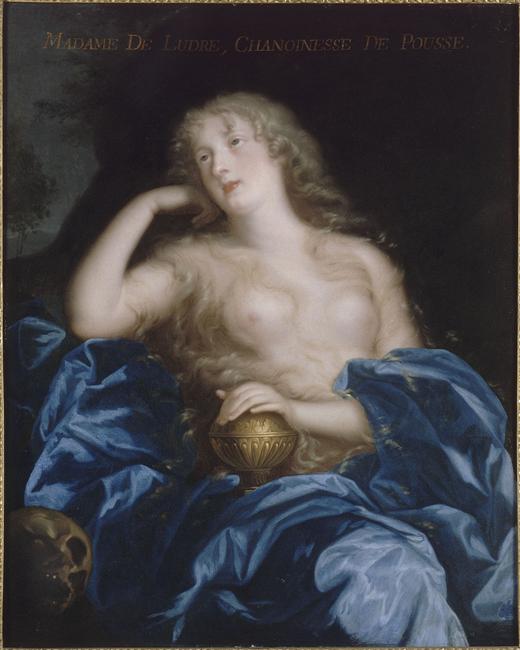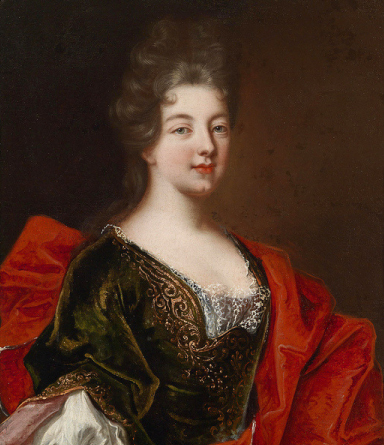The household of Madame, the wife of Louis XIV's only brother, was large by default. When Elizabeth-Charlotte arrived in France as the second wife of Monsieur, she automatically assumed the role of second lady in France. Thus, the establishment which surrounded her had to be suitably large and impressive.
Amongst the more celebrated aspects of her household was the contingent of four filles d'honneur - "girls" in waiting, thus called because of their unmarried state. This also meant that the position was typically meant to be somewhat short-lived and definitely temporary. It would usually be terminated when the young ladies were married off. Consequently, both Henrietta of England and Elizabeth-Charlotte of the Palatinate had plenty of filles d'honneur come and go in their service.
These young ladies were invariably from noble families but there seems to have been another requirement: beauty. The filles d'honneur of Elizabeth-Charlotte were renowned for their beauty which helped to attract more visits from the king himself. Madame herself did not scruple at such an arrangement as she enjoyed the frequent visits from her brother-in-law.
However, the combination of young, beautiful and very eligible ladies and a court dictated by courtly romance, scandals were bound to arise.
 |
| Elizabeth-Charlotte |
The most infamous character from Madame's gaggle of filles d'honneur was Mademoiselle de Fontanges. She was considered immensely beautiful and quickly caught the eye of the king who impregnated her. She was one of the only women who ever posed a serious threat to Madame de Montespan's position and she might just have supplanted her. Yet, Mademoiselle de Fontanges lacked one thing that Madame de Montespan had in abundance: wit. The young Marie Angélique was notoriously "stupid as a basket" but nevertheless charmed the king with her youthful ways. Her pregnancy progressed but when the time came for her to give birth it quickly became apparent that something was wrong. She was prematurely delivered of a son during a childbirth which was a downright disaster. For a while she was thought to recover but was considered "an invalid" due to her ordeal. Sadly, she never recovered and died at just 19 years old.
The household of Madame furnished the king with another mistress: la belle Ludres. The gorgeous Isabelle de Loudres likewise captured the king's attention and had more wit than Fontanges but little intelligence. She was extremely haughty and played her hand too quickly. Flaunting her royal favour and openly fanning suspicions that she, too, might replace Madame de Montespan, the king quickly tired of this drama. It was bad enough that Madame de Montespan was furious at such brazen attempts at supplanting her but even worse that Ludres occasionally gave the impression that she had more power over the king than she actually had. Thus, her time in the king's bed was cut short and she retired to a convent.
 |
| La belle Ludres |
The king was not the only nobleman who searched for love - or variants of it - at the Palais-Royal. Uranie de la Crompte-Beauvais caught the eye of the Comte de Soissons who decided to marry her. This caused some scandal as Uranie was said to be an illegitimate daughter of an écuyer in the service of the Prince de Condé whereas the Comte de Soissons belonged to the powerful Soissons-Carignan family. The marriage was therefore conducted in secret which did not help the scandal. Especially the mother of the groom was furious as the marriage eliminated any chance of an alliance with either a French or a Savoyard princess. Uranie herself is said to have refused the king's advances which led to the couple leaving the French court for Savoy.
Louise de Kéroualle had served the previous Madame - Henrietta of England - and would later set out on an illustrious career as the mistress of Charles II of England. Across the channel her position earned her the title of Duchess of Portsmouth while she enjoyed that of Duchesse d'Aubigny while in France.
The case of Mademoiselle de Loube provides an ample mystery. Françoise de Loube is mentioned directly in one of Madame's numerous letters; on 12 March 1718, Madame refer to the "Loube-affair", seemingly reminiscing of something that happened long ago. However, exactly what this "affair" entailed in not quite clear. Madame did not mention in it any previous (surviving) letter but a few of the other contemporary writers provides bits and pieces of the mystery. A semi-popular ballad refer to the young Loube as yearning for an end to her post as an - unmarried - fille d'honneur. The ballad heavily implies that she was eager to find either a husband or a lover. However, when the Marquis de Dangeau mention her in 1686, she has resolved to become a nun. So, what happened? It is entirely possible that the public ballad was completely wrong; after all, these were often meant to mock and degrade courtiers and thus did not rely on facts. Yet, it is tempting to speculate whether her sudden turn to religion was the result of something else - perhaps an unfortunate love affair?
Either way, Françoise did not become a nun but was potentially transferred to the service of the dauphine in 1689. I have not been able to find any trace of her marrying which further add to the mystery.
 |
| Mademoiselle de Séry |
Even Madame's own son was not immune to the attractions of his mother's household. Philippe II (later regent of France) became enamored with Mademoiselle de Séry. The young lady was born Marie Louise Madeleine Victoire le Bel and served as fille d'honneur when she became pregnant. This immediately caused her dismissal but Philippe II made every gesture to acknowledge to child. For one, he provided her with a house and income before publicly announcing that she was his official mistress. She was later given the title of Comtesse d'Argenton. Their relationship ended in 1710 upon which she asked to become a nun - surprisingly, Philippe refused her request and provided her with a pension and a husband instead.
Whereas Elizabeth-Charlotte enjoyed the royal attention garnered by her pretty attendants, she was far from the only one to use such attributes to manipulate the king. It has been suggested that Anne of Austria and Philippe were eager to dispel rumours that Louis XIV and Henrietta of England were engaged in an affair. The way to do this was to provide the king with a suitable alternative. Consequently, three young women were chosen amongst Madame's own filles d'honneur to provide that distraction. These included a young Louise de La Vallière (the king's first maitresse-en-titre who famously attempted to flee to a convent before being finally permitted to cloister herself) and Bonne de Pons.
By the death of Louis XIV, it was deemed expedient to suppress the office of fille d'honneur to Madame. Elizabeth-Charlotte herself was furious at having to let them, particularly as she suspected the move to that of Madame de Maintenon, her old foe. Madame herself enjoyed the company of her young attendants as they made her laugh. She utterly disagreed that they were unruly as she had both a governess and a sous-governess to educate and chaperone them. Yet considering the many scandalous stories to come from this single part of Madame's household perhaps its suppression was for the best.

No comments:
Post a Comment